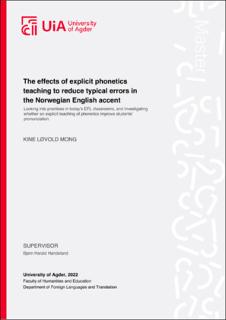| dc.contributor.advisor | Handeland, Bjørn Harald | |
| dc.contributor.author | Mong, Kine Løvold | |
| dc.date.accessioned | 2023-05-25T11:53:26Z | |
| dc.date.available | 2023-05-25T11:53:26Z | |
| dc.date.issued | 2022 | |
| dc.identifier.citation | Mong, Kine Løvold (2022) The effects of explicit phonetics teaching to reduce typical errors in the Norwegian English accent Looking into practices in today’s EFL classrooms, and investigating whether an explicit teaching of phonetics improve students’ pronunciation. | en_US |
| dc.identifier.uri | https://hdl.handle.net/11250/3069008 | |
| dc.description | Master´s thesis in Teacher Education, level 5-10 (EN-503) | en_US |
| dc.description.abstract | This present study investigated how the teaching of phonetics influence Norwegian learners of English’s pronunciation accuracy. It additionally looked at how learners evaluate their own pronunciation and presents some teachers’ perceptions and practices regarding phonetics and oral skills. The data collection consists of seven parts: a standard English proficiency test based on a previous English national test by the Norwegian Directorate for Education and Training, a survey investigating student perceptions on pronunciation, a pre-test testing pronunciation regarding four target phoneme sounds (/θ/, /ð/, /w/, and /v/), a teaching intervention consisting of two lessons, an immediate post-test testing pronunciation on the target phonemes post-intervention, a late post-test testing whether the improved pronunciation is resistant to the passing of time, and a teacher interview looking at teacher perceptions and practices on teaching pronunciation through phonetics. 34 students in year seven and three teachers participated in the study, all recruited from a Norwegian elementary school. The standardized English proficiency test as well as the survey formed a basis for assigning students to either a control group or a test group. Only the test-group was exposed to the teaching intervention, which allows the study to investigate whether there is a correlation between the teaching and the improvement of pronunciation accuracy. The results suggest that the participants in the test-group made significant improvements following the explicit phonetics teaching. The test-group had a total reduction of 47% of their errors from the pre-test to the post-test, with a 32% reduction for /θ/, a 33% reduction for /ð/, an 82% reduction for /w/, and a 52% reduction for /v/. Erroneous use of focus sounds in distraction words was seen in pre-tests, but an 86% reduction of mistakes related to these words was observed. The study interestingly found no correlations between the amount of reduction and students’ perceptions on the importance of good pronunciation and time spent, and neither between the amount of reduction and the students’ reported time spent on improvement. The teacher interviews found that the teacher valued the advantages of phonetic knowledge and they also worked to improve students’ pronunciation in different ways. The interviews found, however, that the teachers mostly avoided teaching explicit phonetics due to a lack of resources. The findings of this low-scale study contribute to the field of teaching phonetics to improve pronunciation by showing that there is a correlation between explicit phonetics teaching and lasting pronunciational improvement | en_US |
| dc.language.iso | eng | en_US |
| dc.publisher | University of Agder | en_US |
| dc.rights | Attribution-NonCommercial-NoDerivatives 4.0 Internasjonal | * |
| dc.rights.uri | http://creativecommons.org/licenses/by-nc-nd/4.0/deed.no | * |
| dc.subject | EN-503 | en_US |
| dc.title | The effects of explicit phonetics teaching to reduce typical errors in the Norwegian English accent Looking into practices in today’s EFL classrooms, and investigating whether an explicit teaching of phonetics improve students’ pronunciation. | en_US |
| dc.type | Master thesis | en_US |
| dc.rights.holder | © 2022 Kine Løvold Mong | en_US |
| dc.subject.nsi | VDP::Humaniora: 000::Språkvitenskapelige fag: 010::Allmenn språkvitenskap og fonetikk: 011 | en_US |
| dc.source.pagenumber | 185 | en_US |

